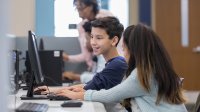6 Key Areas of Middle School Classrooms
These tips will help new teachers prepare their classrooms for the fall and ensure that all of the space is used wisely.
Your content has been saved!
Go to My Saved Content.To say that new middle school teachers are overwhelmed at the start of the school year is an understatement. There are lessons to plan, student information to review, and lots of meetings. So where do you start?
A good place to begin your journey is the physical space of the classroom and the items that will live there. After all, you and your students will spend the vast majority of your time in the classroom, and you’ll want it to be productive and enjoyable. As you begin to set up your middle school classroom, consider creating six distinct spaces to ensure that every bit of valuable real estate in your room is used efficiently.
6 Important Classroom Areas
1. Student takeoff area: It’s a fact—students will arrive to class without supplies, and teachers need a way to handle this issue as it occurs. Having a prominently displayed takeoff area stocked with student supplies will address this problem. When students enter the room, they will have the opportunity to pick up pencils, paper, or anything else they need.
This is an effective way to start class, as it gives students a clear opportunity to acquire all the items they need for the day. This will decrease unnecessary disruptions during instruction and lead to more time on task. At the end of class, the students can return unused items to the designated area.
2. Focal point area: Direct instruction is one of many teaching methods used by educators to help students build knowledge and master learning objectives. In order to deliver whole group instruction effectively, create your focal point area near your whiteboard, interactive whiteboard, or smart TV. This gives you the option to write on the board, AirPlay information, and show video clips all in one place.
Many teachers keep a microphone, speakers, a tablet, and a stylus in this area. A small desk, a podium, and wire clips will help you organize these important communication devices. When it’s time to address the whole class, you can be confident that you have everything you need to communicate effectively.
3. Small group area: Many schools’ mission and vision statements promise to provide a high-quality education for all students. But how does one ensure that all students, with varied needs, receive the instruction to be successful? One way to accomplish this is to work with small groups of students in a designated small group area.
As with your focal point area, you’ll want to have your supplies readily available. A rolling caddy or shelves that contain teaching supplies and manipulatives will keep you and your students from leaving the area in search of supplies and losing instructional time. Arrange your table and chairs facing away from the class. This will minimize distractions and maximize the light bulb moments that teachers love.
4. Technology area: Technology can make learning fun and engaging. However, it can be difficult to keep track of the equipment that is required to integrate technology into your lessons. The internet is filled with tons of creative ways to store technology. For example, shoe organizers are a great option for displaying and quickly accessing headphones, and color-coded cable clips can clean up messy charging wires. No matter how you choose to arrange your area, labeling the technology with numbers or names is the key to holding students accountable for taking care of technology they use during the day.
Don’t forget to post your internet safety rules and procedures in this area as well—this will help keep the equipment and, most important, your students safe.
5. Storage area: Supplies get lost all too often in the classroom. Whether it’s tissues or a dry erase marker, needing something and not being able to locate it can be frustrating. An organized storage area is your best friend. But be careful to not bring in loads of stuff and stick it in the closet—hoarding supplies will make it harder to find what you need. Instead, think of the materials that you and your students use the most, and place them where they are easily accessible. See-through containers, with labels, are a good choice to store items. Place the heavy items on the bottom and the lighter ones on top.
Caution: Don’t create an unsafe environment by blocking emergency exits or walkways.
6. Bulletin boards: Enter any school and you will find lots of colorful, decorative bulletin boards. Besides being aesthetically pleasing, though, bulletin boards can improve student achievement. They can be used to introduce and reinforce new concepts. They can also help you with classroom management. Information such as rules, procedures, and emergency protocols give clear expectations that are crucial in setting up effective routines and processes.
When you’re ready to create your board, use paint or fabric. This makes it easier to change themes. Don’t just make your boards look pretty—use them as a teaching tool. Most important, bulletin boards afford you the opportunity to spotlight the exciting work that is being completed by your students. This will make them feel valued, while also teaching them to appreciate the work of others.
Properly setting up your classroom is an effective way to start the year off on the right foot. Taking the time to thoughtfully plan out your room will create a learning environment that promotes positive interactions and maximizes student achievement.
